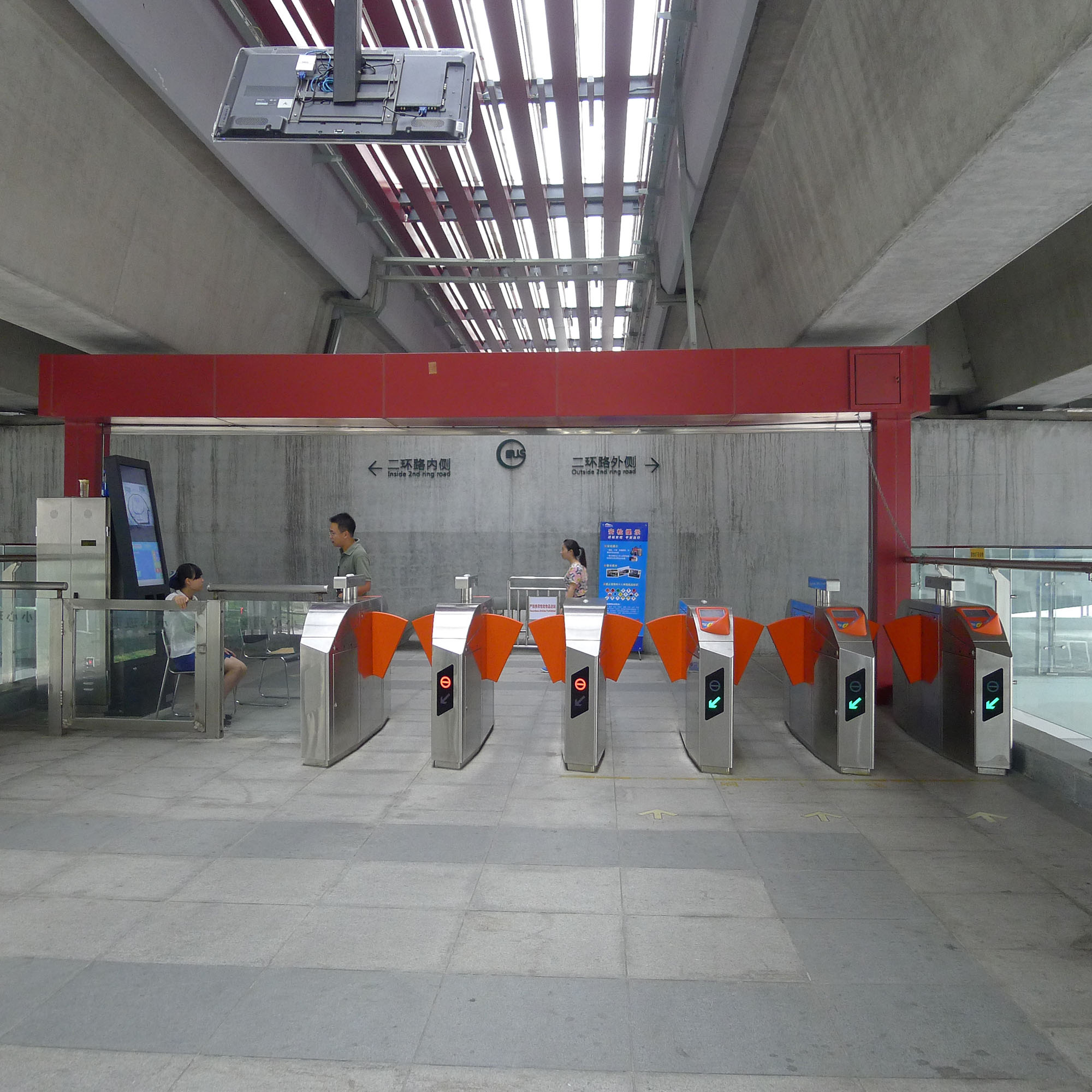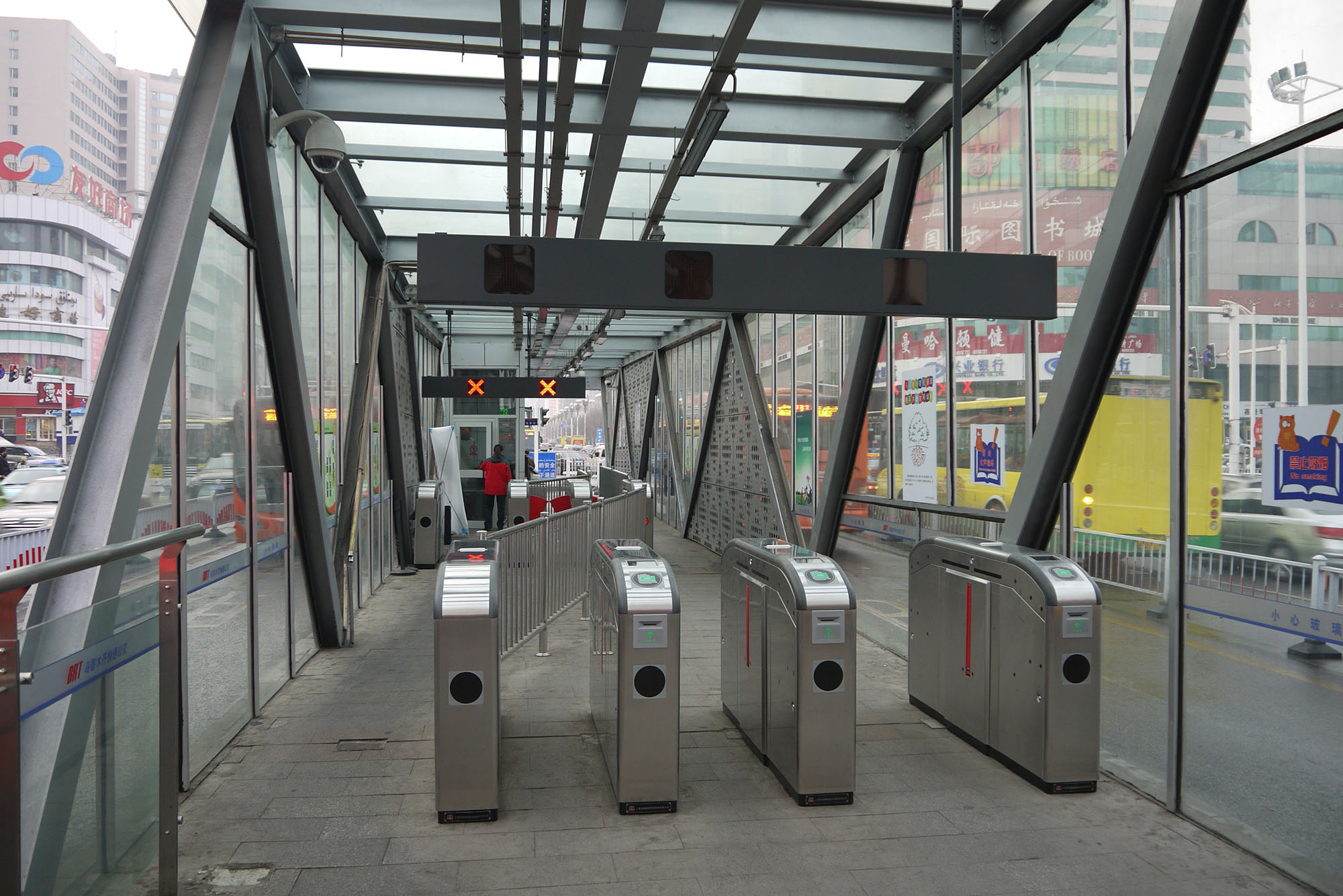18.3Gates and Turnstiles
The world is all gates, all opportunities, strings of tension waiting to be struck.Ralph Waldo Emerson, poet, 1803–1882
Off-board fare collection systems generally employ physical barriers to prevent passengers from entering the system without paying. Most early entry control systems made use of rotating turnstiles. Later developments have resulted in improved and more efficient access control mechanisms with retractable wing gates. Gate arms that pivot horizontally are inexpensive but are generally avoided because they allow entry of more than one person before the arms close.
The turnstile, or tripod gate, is probably the most common access control mechanism used in BRT systems across the world. Once the fare reader authorizes a passage, the tripod is released from a fixed position to rotate a third of a revolution and ensure passage for one person. The TransMilenio BRT system in Bogotá, the Trolebús and Ecovía lines in Quito, Ecuador, and many other systems in South America make use of tripod gates. Tripod gates are not universally accessible to persons with disabilities and users with strollers and suitcases. Alternative access may be provided through manual gates operated by a station attendant. Despite these accessibility challenges, tripod gates are common because of their low maintenance and operating costs.
Retractable wing gates have become standard on many large rapid transit systems such as the London Underground, Hong Kong Metro, and Washington, DC Metro. They also have started to appear in BRT systems, including the Janmarg system in Ahmedabad, India, and the Beijing BRT. The wings are manufactured from durable plastics, glass, or stainless steel. They automatically fold back once the fare reader completes a successful fee transaction. Wing barriers provide a professional appearance while simultaneously preventing fare evasion. They also have advanced detection systems that prevent the flaps from closing while a person or other object—such as a suitcase or stroller—is still passing through. The barriers can also stay open if a second legal passage is detected. The clear opening between the wings can be designed to meet customers’ requirements, including wider gates that permit the passage of wheelchairs.
One consideration in the design of retractable-flap systems is the height of the gate. Most systems utilize waist-high gates, but higher gates are used where there is little oversight and/or a high incidence of fare evasion. The higher the gate, the heavier it becomes, ultimately placing more restrictions on the type of mechanism, flap material, and the speed of opening and closing. Some systems use gates with both heights, with waist-high systems at entrances where there are fare agents and full-height systems where there is less oversight. For example, Quito employs a half-body height turnstile at the entrances that also include the presence of a fare agent.

The typical dimensions and capacities of the different gates are summarized in Table 18.2 (turnstile dimensions are also often customized). The space limitations for BRT stations constructed in road medians pose a challenge in terms of providing sufficient capacity for peak demand at fare gates. Many systems stagger gates or employ bidirectional gates that can be used in any direction, allowing the system to set the orientation of the gates to match the direction of peak passenger flows.

Table 18.2Turnstile Widths
| Category | Type | Height (mm) | Opening Width (mm) | Installation Width (mm) | Capacity |
|---|---|---|---|---|---|
| Waist Height | Retractable | 960–1095 | 500–990 | 820–1580 | 60 persons/min |
| Angle Wing | 1060–1200 | 650–700 | 760–1250 | 60 persons/min | |
| Rotating Arm (Tripod) | 950–1090 | 430–520 | 750–820 | 25–40 persons/min | |
| Swinging Arm | 965–1100 | 600–1200 | 720–1400 | 30 persons/min | |
| Full Height | Angle Wing | 1200–1829 | 500–950 | 760–1690 | 30–60 persons/min |
| Rotating Tripod | 2200 | 600–700 | 1450 | 20 persons/min |
A few BRT systems with onboard fare collection employ onboard physical barriers. Passengers board the bus into a holding area and must tap in to pass by a turnstile. Some other systems, such as the Rea Vaya BRT in Johannesburg, South Africa, also employ fare gates on feeder buses to facilitate the use of an integrated, distance-based fare on the entire BRT network. Rea Vaya feeder buses have tripod gates at the exit doors of buses. The passenger must tap to exit the bus, allowing the system to calculate the distance traveled and the appropriate fare.
Table 18.3Different Fare Collections Systems in Place in BRT Systems around the World.
| City | BRT Standard Level | Name of System | Type of Collection | Barrier Control | Fare Collection Media | Fare Type |
|---|---|---|---|---|---|---|
| US | ||||||
| Cleveland, Ohio | Silver | RTA Healthline | Off board | Machine for validation before boarding | Magnetic card | Flat rate |
| Los Angeles | Bronze | LA Metro Orange Line | Off board | TAP card must be tapped before boarding at validating stations | Smart card | Flat rate |
| Eugene, Oregon | Bronze | Emerald Express (EmX) | Off board | Off-board fare machines | Proof-of-payment, random inspection | Flat rate |
| South America | ||||||
| Lima, Peru | Gold | El Metrobolitano | Off board | Electronic readers/turnstiles | Electronic pre-paid card | Flat rate |
| Buenos Aires, Argentina | Bronze | Metrobus | Onboard | - | Coins/ SUBE smart card | Zonal rate |
| Curitiba, Brazil | Gold | Green Line | Off board | Pre-pay station, turnstiles | Smart card | Flat rate |
| Rio de Janeiro, Brazil | Gold | Transoeste | Off board | Pre-pay station, turnstiles | Electronic prepaid card | Flat rate |
| Barranquilla, Colombia | Silver | Transmetro | Off board | Electronic readers/turnstiles | Electronic prepaid card | Flat rate |
| Cali, Colombia | Silver | MIO (Masivo Integrado de Occidente) | Off board | Contact-free magnetic ticketing | Smart card | Flat rate |
| Perreira, Colombia | Silver | Megabus | Off board | Contact-free magnetic ticketing, turnstiles | Smart card | Flat rate |
| Medellín, Colombia | Gold | Metroplus | Off board | Contact-free magnetic ticketing | Smart card | Flat rate |
| Asia | ||||||
| Guangzhou, China | Gold | Guangzhou BRT | Off board | Fare verification, turnstiles | Smart card | Flat rate |
| Jakarta, Indonesia | Bronze | TransJakarta | Off board | Fare verification, turnstiles | Tickets, prepaid card | Flat rate |
| Ahmedabad, India | Silver | Janmarg | Off board | Fare verification, wing gates, turnstiles | Smart card, tokens | Zonal rate |
| Africa | ||||||
| Johannesburg, South Africa | Silver | Rea Vaya | Off board | Fare verification, wing gates, TAP card entering and exiting stations | Smart card | Zonal rate |
| Cape Town, South Africa | Bronze | MyCity | Off board | Fare verification, wing gates, TAP card entering and exiting stations | Smart card | Zonal rate |